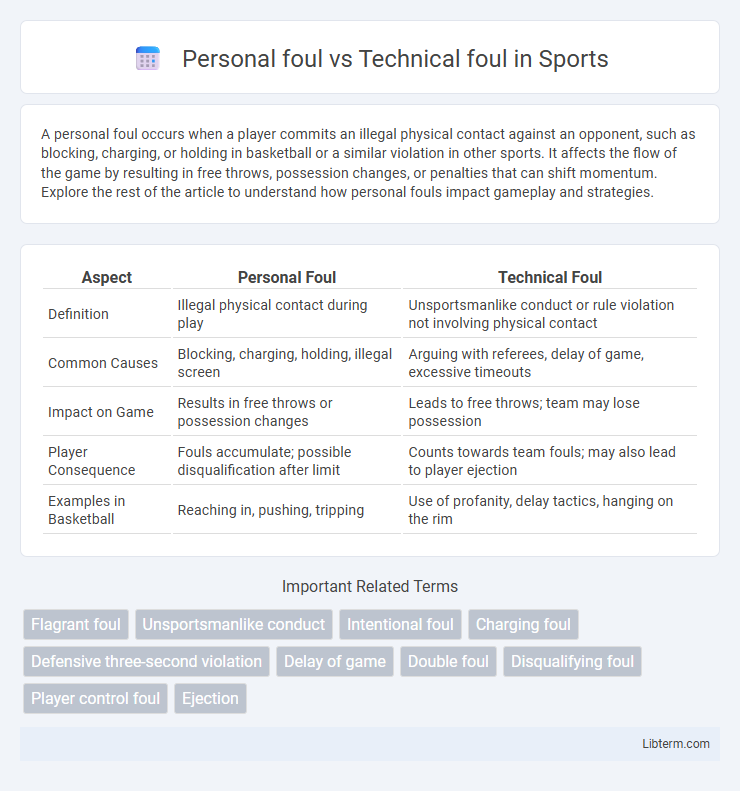A personal foul occurs when a player commits an illegal physical contact against an opponent, such as blocking, charging, or holding in basketball or a similar violation in other sports. It affects the flow of the game by resulting in free throws, possession changes, or penalties that can shift momentum. Explore the rest of the article to understand how personal fouls impact gameplay and strategies.
Table of Comparison
| Aspect | Personal Foul | Technical Foul |
|---|---|---|
| Definition | Illegal physical contact during play | Unsportsmanlike conduct or rule violation not involving physical contact |
| Common Causes | Blocking, charging, holding, illegal screen | Arguing with referees, delay of game, excessive timeouts |
| Impact on Game | Results in free throws or possession changes | Leads to free throws; team may lose possession |
| Player Consequence | Fouls accumulate; possible disqualification after limit | Counts towards team fouls; may also lead to player ejection |
| Examples in Basketball | Reaching in, pushing, tripping | Use of profanity, delay tactics, hanging on the rim |
Understanding Personal Fouls in Sports
Personal fouls in sports occur when a player commits illegal physical contact against an opponent, such as pushing, holding, or tripping, which directly affects gameplay and player safety. These fouls typically result in free throws or possession changes, depending on the sport's rules, and are tracked individually as part of a player's penalty count. Understanding personal fouls is essential for players and coaches to maintain fair play and avoid disadvantages during critical moments in basketball, football, and other contact sports.
Defining Technical Fouls: An Overview
Technical fouls are violations that typically involve unsportsmanlike conduct, rule infractions, or procedural errors rather than physical contact during gameplay. Unlike personal fouls, which penalize physical contact against opponents, technical fouls address behaviors such as arguing with referees, delaying the game, or improper substitutions. These fouls result in free throws for the opposing team and do not affect individual foul counts related to player disqualifications.
Key Differences Between Personal and Technical Fouls
Personal fouls occur when a player makes illegal physical contact with an opponent during gameplay, affecting ball control or player movement. Technical fouls result from unsportsmanlike behavior, rule violations, or infractions by players, coaches, or team staff that do not involve physical contact. Key distinctions include the nature of the offense--physical contact versus conduct--and the penalties, where personal fouls often lead to free throws or possession changes, while technical fouls typically incur free throws and possible ejections.
Common Scenarios for Personal Fouls
Personal fouls commonly occur during physical contact in basketball, such as blocking, charging, or holding an opponent to impede their movement. Defenders frequently commit personal fouls when attempting to steal the ball or contest a shot without making legal contact. These fouls result in free throws or possession changes depending on the foul situation and game context.
Typical Situations Leading to Technical Fouls
Technical fouls typically arise from unsportsmanlike conduct such as arguing with referees, excessive timeouts, or illegal substitutions, contrasting with personal fouls that involve physical contact during play. Common scenarios include players or coaches displaying disrespectful behavior, delaying the game intentionally, or violating administrative rules. Understanding these distinctions is crucial for maintaining discipline and fair play in basketball games.
Impact of Personal Fouls on Game Play
Personal fouls directly affect game play by limiting a player's ability to remain on the court, as accumulating too many results in fouling out and reduces team depth. These fouls often lead to free throws for the opposing team, increasing scoring opportunities and shifting game momentum. Teams must adjust defensive strategies to protect key players from fouling out, which can alter overall game dynamics and player aggression.
Consequences of Technical Fouls for Teams and Players
Technical fouls result in immediate free throws awarded to the opposing team, often shifting game momentum and increasing the opponent's scoring opportunities. For players, accumulating technical fouls leads to fines, suspensions, and potential ejection from the game, impacting team performance and roster availability. Teams facing multiple technical fouls risk diminished cohesion and increased penalties, which can critically alter the outcome of competitive basketball matches.
How Referees Identify and Call Each Foul
Referees identify personal fouls by observing illegal physical contact during player interactions, such as blocking, holding, or charging, which directly affect gameplay and player movement. Technical fouls are called based on unsportsmanlike conduct, procedural violations, or infractions unrelated to physical contact, like arguing with officials or delay of game. Officials rely on clear rules, situational awareness, and player behavior patterns to distinguish between personal and technical fouls, ensuring accurate and consistent enforcement.
Strategies for Avoiding Personal and Technical Fouls
To minimize personal fouls, players should emphasize proper defensive positioning, maintain controlled physical contact, and avoid reckless challenges that lead to unnecessary penalties. Coaches encourage athletes to develop emotional control and situational awareness to prevent technical fouls often caused by dissent or unsportsmanlike conduct. Implementing consistent discipline and reinforcing the importance of respect for referees and opponents help maintain focus and reduce foul occurrences.
Frequently Asked Questions: Personal Foul vs Technical Foul
Personal fouls involve physical contact violations such as blocking, holding, or pushing during gameplay, resulting in free throws or ball possession for the opposing team. Technical fouls are penalties for unsportsmanlike conduct, like arguing with officials or delay of game, usually leading to free throws without ball possession change. Common questions distinguish personal fouls as in-game contact infractions, while technical fouls address behavioral or procedural violations off actual play.
Personal foul Infographic

 libterm.com
libterm.com